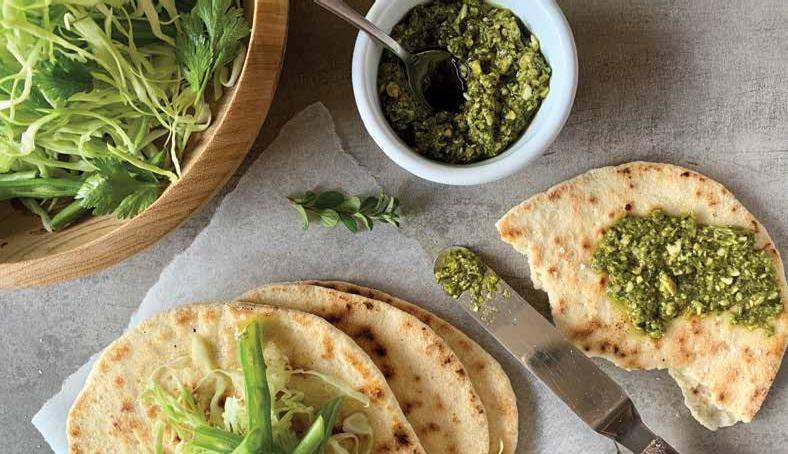
6 minute read
Summer Sharing
RECIPES & IMAGES KATHY PATERSON
Bo Ssam
A Korean pork dish, usually pork shoulder, cooked in spices then thinly sliced. Traditionally paired with shucked oysters, steamed short-grain rice, kimchi, quick pickles, a ginger and spring onion sauce and lettuce leaves. Cooking of the pork in this recipe is inspired by American chef David Chang and Australian chef Karen Martini and their interpretation.
SLOW-COOKED PORK SHOULDER
Begin this recipe the day before. This pork is delicious warm, but I think even better when cold as the flavour intensifies.
1 cup soft brown sugar 2 tbsp flaky sea salt, plus extra for crackling 2.3–2.5kg bone in pork shoulder, skin on 175ml rice wine vinegar Combine the sugar and salt in a large ceramic ovenproof dish. Add the pork shoulder and rub all over with the sugar and salt mixture. Put in the fridge overnight—no need to cover.
The following day:
Preheat the oven to 180°C. Remove the pork from the dish leaving any remaining sugar and salt mixture on the meat. Discard remaining pan juices and wash out the dish. Return pork, skin-side-up, to the dish and pour over the vinegar. Cover with a lid or baking paper and foil and put in the oven. Cook for 2 hours, then uncover and cook for a further 1 hour.
Line a shallow baking tray with baking paper. Remove pork from the oven and lift off the skin and put on the prepared tray. Baste the pork with the cooking juices and return to the oven for a further 1 hour, basting with the juices twice. At this stage the meat should pull easily away from the bone. Leave the pork to rest. I prefer to leave at room temperature for 30 minutes before serving. Pour the cooking juices into a small pot. You can remove the fat from the surface if you wish.
Turn the oven up so it’s very hot. Rub a little extra salt over the pork skin then put in the oven for 10–15 minutes until crisp. Keep an eye on it.
TO SERVE:
red or green butterhead lettuce leaves slow-cooked pork pulled into shreds meat juices to moisten, warmed 1 medium-sized cucumber, cut in half lengthwise and sliced kimchi (we recommend Good Bugs Kick Ass Kimchi or their Ginger Ninja) Korean fermented chilli sauce (recipe below) coriander leaves lime or lemon wedges pork crackling, cut into small pieces store-bought Chinese bao buns, steamed, optional Fill the lettuce leaves with shredded pork drizzled with the warmed meat juices. Top with cucumber slices, kimchi, chilli sauce and coriander leaves. Drizzle with lime or lemon juice and top with crackling. Or fill into bao buns.
Have plenty of napkins for your hands.
KOREAN FERMENTED CHILLI SAUCE
Make up in small batches as this sauce is at its best freshly made.
Makes about ½ cup
¼ cup gochujang 1½ tbsp miso paste 1 tbsp soft brown sugar 1 tbsp rice wine vinegar ½ tbsp sesame oil 1 tbsp white sesame seeds 4 cm piece fresh ginger vegetable oil and water to thin Combine the gochujang, miso paste, brown sugar, vinegar, sesame oil and sesame seeds in a small bowl. Finely grate the fresh ginger straight into the bowl. Mix well, adding a little vegetable oil and a splash or two of cold water to thin to a sauce consistency.
Use sauce straight away or keep well covered in the fridge for 2–3 days.
DID YOU KNOW?
Gochujang is an essential ingredient in Korean cooking and is made from red chillies, glutinous rice and soybeans. Traditionally made at home but now available commercially, look for a tub of the hot pepper paste in Asian supermarkets or at your local supermarket. If they are not stocking it then chat to them about doing so.

MAKE YOUR PLATTER SHINE THIS SUMMER

With our award winning cheeses, proudly made in the Waikato.
AVAILABLE AT ALL GOOD CHEESE STORES
Homemade Pita Bread with Fermented Pesto

Pita bread is fun to make—you can roll your own dough then pop it on the barbecue hot plate to cook. I pulled this recipe from The Sunday Life magazine in the Melbourne Age many years ago—so long in fact that the paper is very discoloured. I have changed the method to the way I prefer to make yeast breads.
Makes 12 large pita bread
1 tbsp sugar 1½ tsp active dried yeast 375ml warm water 4 cups (500g) plain flour or use bread flour 2 tsp salt ½ heaped cup (100g) fine semolina 1 tbsp olive oil, plus extra for brushing Good Bugs fermented pesto for topping
Put the sugar and yeast in a small bowl and pour in about 75ml of the measured warm water. Leave in a warm place until frothy (about 5 minutes).
Sift the flour and salt into the bowl of an electric mixer fitted with a dough hook. Add the semolina, oil and remaining water along with the frothy yeast mixture. Knead for about 10 minutes until the dough is smooth. You can also knead by hand if you don’t have a mixer, it’s very therapeutic.
Tip dough out of the bowl then lightly oil the bowl to prevent sticking during rising. Return dough to the bowl and turn over to oil the top surface of the dough.
Cover bowl well with a clean tea towel and leave in a warm place until the dough doubles in size (about 1 hour).
Tip dough out onto a floured bench and knead for a further minute. Cut the dough into 12 even-sized pieces. Cover pieces with a tea towel to prevent them from drying out and again keeping everything warm.
Heat a barbecue hot plate or a heavy-based frying pan over medium-high heat. Lightly brush with oil to prevent sticking.
Start by rolling a piece of dough into a thin round pita bread shape. Prick pita bread well with a fork then put on the hot plate or in the hot pan. Cook on each side until lightly browned. Repeat with the remaining pieces of dough, stacking pita bread on a clean tea towel and putting a small piece of baking paper between each one.
Serve pita bread spread with a little fermented pesto.
Tips – your first pita bread will be the test to see if you have rolled the dough thin enough to give you the traditional pita bread shape.
Store any extra pita breads in the freezer—make sure they are well wrapped.
GREEN COLESLAW WITH FERMENTED PESTO VINAIGRETTE
1 tbsp lemon juice 4 tbsp extra virgin olive oil 1 tbsp Good Bugs fermented pesto salt and pepper
GREEN COLESLAW
8 handfuls of very finely shredded green cabbage 2 handfuls of small green beans, sliced and lightly steamed or leave raw if picked fresh from the garden 2 handfuls of picked soft herb leaves, such as coriander, flat leaf parsley, a few snipped chives, a few mint leaves or sweet marjoram leaves To make the vinaigrette, put the lemon juice, oil, fermented pesto and salt and pepper in a screw-top jar. Shake well then check seasoning.
To make the coleslaw, put the cabbage, green beans and herb leaves in a serving bowl. Drizzle over enough vinaigrette to moisten and gently toss to combine.
Kathy Paterson
Kathy Paterson is a recipe developer, food stylist and photographer. A plentiful herb garden and a trial and error vegetable garden give Kathy the starting place for her recipes along with her love of the classics with a modern twist.










